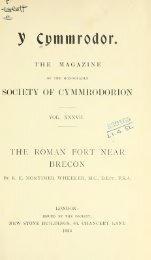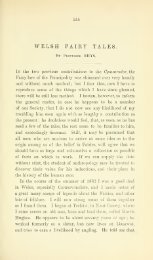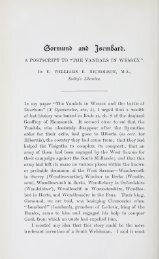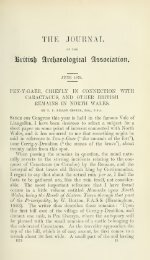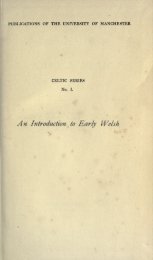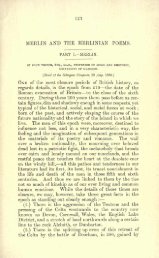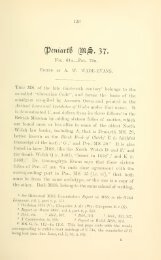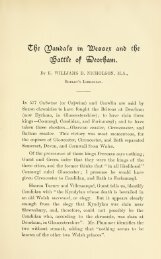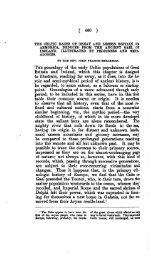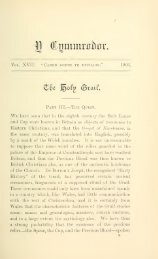Z§t €0rono£o$2 of QWflur. - Arthur Pendragon of Wales
Z§t €0rono£o$2 of QWflur. - Arthur Pendragon of Wales
Z§t €0rono£o$2 of QWflur. - Arthur Pendragon of Wales
Create successful ePaper yourself
Turn your PDF publications into a flip-book with our unique Google optimized e-Paper software.
<strong>Z§t</strong> <strong>€0rono£o$2</strong> <strong>of</strong> <strong>QWflur</strong>.<br />
By the Rev. A. W. Wade-Evans,<br />
Vicar <strong>of</strong> France Lynch, Glos.<br />
" Wele'n awr y mae ein taith o'r diwedd wedi ein harwain ni hyd<br />
at vrenhinllys y penadur dieithr ac anirnadadwy hwnnw sy wedi peri<br />
cymaint o ddyryswch i hanesyddion a chwilwyr llenyddol yn yr<br />
oesoedd diweddar." Carnhuanawc (1836-1842).<br />
CHAPTER I.<br />
(a) Evidence <strong>of</strong> the Excidiura Brittaniae.<br />
In ch. 26 <strong>of</strong> the Excidium Brittaniae the siege <strong>of</strong><br />
Badonicus Moris is given as occurring in "the forty-fourth<br />
year with one month already elapsed". Bede, in his<br />
Historia Ecclesiastica i, 16, interpreted this passage as<br />
meaning the forty-fourth year from the Advent <strong>of</strong> the<br />
Saxons into Brittania at Vortigern's invitation. According<br />
to the Bedan date <strong>of</strong> this last event (449), the siege would<br />
have taken place in (449 + 43) =492. According to a British<br />
date (428), it would be (428 + 43) =471; and as the annalistic<br />
year in the fifth century commenced on September 1st with<br />
the indiction, 471 would mean our September 1st, 470, to<br />
August 31st, 471. If, then, the siege took place when the<br />
first month <strong>of</strong> the year had already elapsed, the date<br />
would be October, 470.<br />
(b) Evidence <strong>of</strong> the so-called Annales Cambriae.<br />
Two incidents in <strong>Arthur</strong>'s life are dated in the so-called<br />
Annales Cambriae as follows :<br />
Annus lxxii. The Battle <strong>of</strong> Badon, in which<br />
<strong>Arthur</strong> carried the cross <strong>of</strong> our Lord Jesus<br />
Christ, for three days and three nights on his<br />
shoulders, and the Britons were victorious.
io6 The Chronology <strong>of</strong> <strong>Arthur</strong>.<br />
Annus xcin. The Action <strong>of</strong> Camlann, in which<br />
<strong>Arthur</strong> and Medraut perished.<br />
In the era <strong>of</strong> the Annates Cambriae, Annus lxxii gives<br />
(445 + 71) =516/ which does not correspond with "the<br />
forty-fourth year" <strong>of</strong> the Excidium Brittaniae whether this<br />
forty-fourth year be computed from 428 or 449. Nor does it<br />
give satisfaction if we equate the forty-fourth year with 516,<br />
and then compute backwards for the equivalent <strong>of</strong> Annus<br />
I, because we merely reach (516 minus 43)=473, which<br />
is otherwise unknown as an initial year for chronological<br />
calculation. In no way can we make Annus lxxii tally<br />
with the forty-fourth year <strong>of</strong> the Excidium Brittaniae by<br />
any calculation from initial years which are known to have<br />
been used for purposes <strong>of</strong> chronology, except by computing<br />
Annus lxxii from that year <strong>of</strong> Stilicho's consulship<br />
which is actually used as an initial year in the calculations<br />
which preface MS. A <strong>of</strong> the Annates Cambrice, viz., the<br />
year 400. If Annus lxxii be computed from this year <strong>of</strong><br />
Stilicho's consulship, we get 400+71=471; and as 471<br />
means our Sept. 1st, 470 to Aug. 31st, 471, and as the<br />
siege occurred in the second month, we again arrive at<br />
October 470.<br />
The other <strong>Arthur</strong>ian annal from the same initial year<br />
gives as the date <strong>of</strong> the Action <strong>of</strong> Camlann and <strong>Arthur</strong>'s<br />
1 There are still many students who do not seem to have observed<br />
that the editorial equation <strong>of</strong> Annus I <strong>of</strong> the so-called Annates<br />
Cambriae with the year 444 is in flat contradiction to the editorial<br />
equations <strong>of</strong> the other Anni <strong>of</strong> this chronicle, which are all based on<br />
the equation <strong>of</strong> Annus I with 445. For example, if Annus lxxii in the<br />
era <strong>of</strong> the Annales Cambriae is 516, as everybody agrees, then Annus I<br />
cannot possibly be 444. Surely it is not necessary to have to explain<br />
that if Annus lxxii in the era <strong>of</strong> the Annales Cambriae is the<br />
equivalent <strong>of</strong> 516, as everybody agrees, the way to find the equivalent<br />
<strong>of</strong> Annus I is to subtract from 516 not 72 but 71 ; or must it be set<br />
forth in sober print that if Annus II be 446, Annus J will not be 446<br />
minus 2 ?
The Chronology <strong>of</strong> <strong>Arthur</strong>. 107<br />
death therein (400 + 92)=492, that is, our Sept. 1st, 491<br />
to Aug. 31st, 492.<br />
(c) Evidence <strong>of</strong> the Historia Brittonum.<br />
In ch. 56 <strong>of</strong> the Historia Brittonum, the statement that<br />
<strong>Arthur</strong> "carried the image <strong>of</strong> Saint Mary, perpetual virgin,<br />
on his shoulders, and the pagans were put to flight on that<br />
day, and a great slaughter was inflicted on them through<br />
the power <strong>of</strong> our Lord Jesus Christ, and through the power<br />
<strong>of</strong> Saint Mary, his mother" is associated with <strong>Arthur</strong>'s<br />
eighth victory, viz., the Battle <strong>of</strong> Castellum Guinnion,and<br />
not with the Battle <strong>of</strong> Mons Badonis.<br />
As to the Battle <strong>of</strong> Mons Badonis, <strong>Arthur</strong> is described<br />
as having slain 940 or 960 or 440 men in one day ;<br />
and it<br />
is particularly stated that he did this by himself without<br />
assistance.<br />
(d) Evidence <strong>of</strong> the Historia Regum Brittaniae.<br />
In Book ix, ch. 1, Ge<strong>of</strong>frey states that <strong>Arthur</strong> was in<br />
his fifteenth year when he began to reign, but does not<br />
give the interval <strong>of</strong> time which elapsed between his suc-<br />
cession to power and his first attack on his foreign foe.<br />
As he mentions twelve years <strong>of</strong> the reign in Book ix,<br />
ch. 10, and another nine years in the following chapter,<br />
<strong>Arthur</strong> must have ruled at least twelve plus nine, or twenty<br />
one years.<br />
In the same ch. 11 <strong>of</strong> Book ix <strong>Arthur</strong> is made to land<br />
in Gaul, which is said to have been committed at that time<br />
to the charge <strong>of</strong> a certain Flollo, tribune <strong>of</strong> Rome, under<br />
the Emperor Leo. This Emperor Leo must either be<br />
Leo I, who ruled in the East from 457 to 474, or his sue-,<br />
cessor Leo II, who only ruled for a few months in 474<br />
for the next emperor <strong>of</strong> this name did not live till the<br />
eighth century. Leo is mentioned again as <strong>Arthur</strong>'s con-
108 The Chronology <strong>of</strong> <strong>Arthur</strong>.<br />
temporary in Book x, ch. 6, and in Book xi, ch. 1. As<br />
<strong>Arthur</strong> reigned at least twenty one years, and the two<br />
Leos only seventeen years between them, a portion <strong>of</strong><br />
<strong>Arthur</strong>'s regnal period must have fallen within the years<br />
457 to 474, and another portion must have fallen outside<br />
them.<br />
In Book viii, ch. 20, Ge<strong>of</strong>frey tells us that <strong>Arthur</strong> had<br />
a sister called Anna, who was married to Lot (Book viii,<br />
ch. 21) and became the mother <strong>of</strong> Walvanus (Gwalchmai).<br />
When <strong>Arthur</strong> had reached at least the twelfth year <strong>of</strong> his<br />
reign (Book ix, ch. 10), Walvanus was in his twelfth year,<br />
having already received arms from Pope Sulpicius or<br />
Suplicius, into whose service <strong>Arthur</strong> had sent him<br />
(Book ix, ch. 11). This Pope can be no other than Pope<br />
Simplicius, who ruled from 468 to 483. As <strong>Arthur</strong>'s<br />
reign reached a tenth year after receiving the boy from<br />
Pope Simplicius (Book ix, ch. 11 ; Book x, ch 13), it must<br />
have extended to a tenth year from one <strong>of</strong> those during<br />
which Simplicius was Pope, that is, <strong>Arthur</strong>'s reign must<br />
have terminated from (468 + 9) to (483 + 9), that is, from<br />
477 to 492. It is certain therefore that <strong>Arthur</strong> ruled<br />
at least three years after the death <strong>of</strong> the Emperors<br />
Leo I and II in 474 ; and also that <strong>Arthur</strong> died sometime<br />
from 477 to 492.<br />
In Book ix, ch. 4, Ge<strong>of</strong>frey unexpectedly and as it<br />
would seem unwittingly clears up the mystery surrounding<br />
<strong>Arthur</strong>'s slaughter <strong>of</strong> 940 or 960 or 440 men at Mons<br />
Badonis by giving the number as 470, which is now seen<br />
to be none other than the date <strong>of</strong> the battle in our own<br />
familiar era. How the blunder in the Historia Brittonum<br />
originally arose is not easy to determine. "In uno die<br />
dccccxl," etc., may be a misreading for some form <strong>of</strong> "in<br />
a d cccclxx " that is, in anno domini cccclxx ; or there<br />
may be some other explanation. But in any case Ge<strong>of</strong>frey
The Chronology <strong>of</strong> <strong>Arthur</strong>, 109<br />
seems to have copied the number 470, which in the light<br />
<strong>of</strong> our other evidence, and especially in the light <strong>of</strong> the<br />
evidence <strong>of</strong> Ge<strong>of</strong>frey himself, is clearly a date in the<br />
Dionysian era.<br />
Ge<strong>of</strong>frey therefore beyond all doubt is following a con-<br />
sistent tradition which places <strong>Arthur</strong>'s victories and death<br />
within the last half <strong>of</strong> the fifth century. But that he<br />
overlooked the limits <strong>of</strong> time postulated by his references<br />
to Pope Simplicius and the Emperor Leo appears evident<br />
from the very definite date to which he ascribes <strong>Arthur</strong>'s<br />
defeat in Book xi, ch. 2, namely, the year 542. In giving<br />
this definite date Ge<strong>of</strong>frey departs from his usual practice,<br />
and as by so doing he here dislocates the chronology<br />
which he appears to be unwittingly following, it is clearly<br />
an importation from another source. The date 542 is as<br />
designed as the implicit dates demanded by the references<br />
to Pope and Emperor are undesigned. What then is<br />
Ge<strong>of</strong>frey's authority for 542 as the year <strong>of</strong> <strong>Arthur</strong>'s fall at<br />
Camlan ? I do not hesitate to say that it is the Annales<br />
Gambriae, in which, as we have seen, Camlan is placed<br />
opposite Annus xciii. Ge<strong>of</strong>frey equated Annus 1 with the<br />
Bedan date <strong>of</strong> the Saxon Advent, viz., 449, to which he<br />
simply added according to his wont Annus xciii with the<br />
above result (449 + 93) =542.<br />
As <strong>Arthur</strong> was in his fifteenth year when be began to<br />
reign, and as the parents assigned to him by Ge<strong>of</strong>frey,<br />
namely, Uther and Igerna, came together after Uther had<br />
been made king, Uther must have reigned at least fifteen<br />
years.<br />
In Book viii, chs. 14 and 15, the death <strong>of</strong> Aurelius<br />
Ambrosius, whom Uther succeeded, is made to synchronize<br />
with the appearance <strong>of</strong> a comet <strong>of</strong> extraordinary brilliance<br />
and magnitude. The only phenomenon <strong>of</strong> this description,<br />
which our chronology allows, is the comet which appeared
1 10 The Chronology <strong>of</strong> <strong>Arthur</strong>.<br />
in the winter <strong>of</strong> 442-3. It is mentioned by Idatius and<br />
Marcellinus, and was visible in Britain. In the following<br />
Easter Uther meets Igerna (viii, 19), marrying her soon<br />
afterwards, <strong>Arthur</strong>'s birth occurring probably the next<br />
year, viz., 444. As <strong>Arthur</strong> was in his fifteenth year<br />
when he began to reign, Uther must have ruled till<br />
(444+ 14) =458. This would mean that <strong>Arthur</strong> was a<br />
contemporary <strong>of</strong> the Emperors Leo I, Leo II, and Zeno.<br />
Assuming now that <strong>Arthur</strong> won at Mons Badonis in<br />
October 470, let us follow Ge<strong>of</strong>frey's chronology <strong>of</strong> sub-<br />
sequent events in <strong>Arthur</strong>'s career, which I read as<br />
follows :<br />
ix, 8. <strong>Arthur</strong> is made to celebrate the following<br />
Christmas at York, i.e., Christmas, 470.<br />
ix, 10. <strong>Arthur</strong> .<br />
is made to land in Ireland in the<br />
following summer, i.e., the summer <strong>of</strong> 471.<br />
<strong>Arthur</strong> is made to return to Britain at the<br />
close <strong>of</strong> winter, i.e., the close <strong>of</strong> winter, 472.<br />
<strong>Arthur</strong> is made to remain in Britain, ordering<br />
the affairs <strong>of</strong> his realm till the twelfth year,<br />
i.e. 472 + 11 = 483.<br />
ix, 11. In 483, then, <strong>Arthur</strong> is made to attack<br />
Norway, Denmark, and Gaul. At this time<br />
Walvanus is in his twelfth year, having re-<br />
ceived arms from Pope Simplicius, who, as<br />
a matter <strong>of</strong> fact, died in this very year, 483.<br />
Walvanus, therefore, was born in 472. In<br />
the ninth year <strong>Arthur</strong> is made to return to<br />
Britain in early spring, i.e., the early spring<br />
<strong>of</strong> (483 + 8) =491.<br />
ix, 12. <strong>Arthur</strong> is made to celebrate the Whitsun<br />
Festival at Caerlleon, i.e., Whitsun, 491.<br />
ix, 15. The Romans are made to order <strong>Arthur</strong>'s<br />
appearance at Bome by the middle <strong>of</strong> August
The Chronology <strong>of</strong> <strong>Arthur</strong>. 1 1<br />
in the following year, i.e., mid-August, 492.<br />
For some five years previous to Whitsun, 491,<br />
<strong>Arthur</strong> had engaged in no war (cf. also x, 7),<br />
i.e. (491 minus 4) to 491, i.e., 487 to 491.<br />
ix, 20 ; x, 2. <strong>Arthur</strong> is made to start for Rome at<br />
the beginning <strong>of</strong> August, i.e., August, 491.<br />
x, 13. <strong>Arthur</strong> is made to remain subduing the<br />
cities <strong>of</strong> the Allobroges in Gaul throughout<br />
the following winter, i.e., 491-2 ; and with the<br />
opening summer to ascend the mountain passes<br />
for the City <strong>of</strong> Rome, i.e., the opening summer<br />
<strong>of</strong> 492. At this point the news arrives <strong>of</strong><br />
Modred's rebellion.<br />
xi, 1. <strong>Arthur</strong> is made to hurry back to Britain,<br />
postponing his expedition against the Emperor<br />
"Leo". Battles are fought in rapid succession<br />
at Richborough, Winchester, and Camlan.<br />
In the latter <strong>Arthur</strong> falls, presumably in the<br />
summer <strong>of</strong> 492.<br />
Ge<strong>of</strong>frey was certainly wrong in continuing the reign<br />
<strong>of</strong> the Emperor Leo to the year <strong>of</strong> <strong>Arthur</strong>'s defeat at<br />
Camlan, for both Leos died in 474 ; and, as we have seen,<br />
the reference to Pope Simplicius and Walvanus extends<br />
<strong>Arthur</strong>'s reign years after the death <strong>of</strong> the Leos, and<br />
indeed makes <strong>Arthur</strong>'s reign to terminate from 477 to<br />
492.<br />
CHAPTER II.<br />
Badonictjs Mons.<br />
(a) Evidence <strong>of</strong> the so-called Annales Cambriae.<br />
The earliest MS. extant <strong>of</strong> the document, which now<br />
goes under the unsatisfactory title <strong>of</strong> Annates Cambriae,<br />
contains two entries, which I read as follows :<br />
Annus lxxii.—The Battle <strong>of</strong> Badon, in which<br />
<strong>Arthur</strong> carried the cross <strong>of</strong> our Lord Jesus<br />
k2
1 1 The Chronology <strong>of</strong> <strong>Arthur</strong>.<br />
Christ for three days and three nights on his<br />
shoulders ; and the Britons were the van-<br />
quishers.<br />
Annus ccxxi.—The Battle <strong>of</strong> Badon for the second<br />
time.<br />
The first <strong>of</strong> these, as we have seen, refers to an event<br />
which took place in October, 470, a.d.<br />
The second is presumably an event <strong>of</strong> the latter half <strong>of</strong><br />
the 7th century, for Annus ccxxi, in the era <strong>of</strong> the<br />
Annates Cambriae, is 445 + 220=665.<br />
(b) Evidence <strong>of</strong> the Historia Brittonum.<br />
The Annates Cambriae (MS. A) was compiled about the<br />
mid-tenth century as a continuation <strong>of</strong> the Historia<br />
Brittonum and the other writings, which are associated<br />
with the name <strong>of</strong> Nennius, or, at least, as an addition to<br />
them. The Historia Brittonum, therefore, is the older<br />
authority.<br />
In the enumeration <strong>of</strong> <strong>Arthur</strong>'s twelve victories in ch.<br />
56 <strong>of</strong> the Historia Brittonum the following items appear<br />
among others :<br />
The eighth was the battle at Castellum Guinnion, in<br />
which <strong>Arthur</strong> carried the image <strong>of</strong> Saint Mary,<br />
perpetual Virgin, on his shoulders, and the<br />
Pagans were put to flight on that day, and a<br />
great slaughter was inflicted on them through<br />
the power <strong>of</strong> our Lord Jesus Christ and through<br />
the power <strong>of</strong> Saint Mary his mother.<br />
The twelfth was the battle at Mons Badonis, in<br />
which 960 men fell in one day through one<br />
onset <strong>of</strong> <strong>Arthur</strong>; and no one overthrew them<br />
except himself alone.<br />
Now it will be immediately observed that the portage<br />
<strong>of</strong> Christian symbols on <strong>Arthur</strong>'s shoulders is stated in
The Chronology <strong>of</strong> <strong>Arthur</strong>. 1 13<br />
the older tradition <strong>of</strong> the Historia Brittonum to have<br />
occurred in the battle <strong>of</strong> Castellum Guinnion and not<br />
in that <strong>of</strong> Mons Badonis. And as the battle <strong>of</strong> Castellum<br />
Guinnion became much less known than that <strong>of</strong> Mons<br />
Badonis (which last indeed has long been world famous),<br />
there would be a greater and an increasing tendency to<br />
ascribe these particulars, whereby <strong>Arthur</strong> figures as a<br />
Champion <strong>of</strong> Christendom, to the battle <strong>of</strong> Badon rather<br />
than the reverse. The older tradition, therefore, <strong>of</strong> the<br />
Historia Brittonum is to be preferred to the later statement<br />
<strong>of</strong> the Annates Gambriae, and the original pre-eminence<br />
<strong>of</strong> the battle <strong>of</strong> Castellum Guinnion in this particular<br />
is to be restored as against the battle <strong>of</strong> Badon.<br />
Indeed, if we omit the statement as to the slaughter <strong>of</strong><br />
960 men in the battle <strong>of</strong> Badon (which we have seen to be<br />
a mere bungle as to a simple date in the Dionysian era), it<br />
will be found that in the list <strong>of</strong> <strong>Arthur</strong>'s victories the<br />
battle <strong>of</strong> Castellum Guinnion stands alone as to any<br />
record <strong>of</strong> details. The list, translated from Mommsen's<br />
text, reads as follows :<br />
The first battle was at the mouth <strong>of</strong> the river which is<br />
called Glein.<br />
The second, third, fourth, and fifth, on another river<br />
which is called Dubglas, and is in the region <strong>of</strong> Linnuis.<br />
The sixth battle on the river which is called Bassas.<br />
The seventh was the battle in the wood <strong>of</strong> Celidon, that<br />
is Cat Coit Celidon.<br />
The eighth was the battle at Castellum Guinnion, in<br />
which <strong>Arthur</strong> carried the image <strong>of</strong> Saint Mary, perpetual<br />
virgin, on his shoulders, and the Pagans were put to flight<br />
on that day, and a great slaughter was inflicted on them<br />
through the power <strong>of</strong> our Lord Jesus Christ and through<br />
the power <strong>of</strong> Saint Mary the Virgin, his mother.<br />
The ninth battle was fought in the city <strong>of</strong> Legion.
Ii4 The Chronology <strong>of</strong> <strong>Arthur</strong>,<br />
The tenth battle occurred on the shore <strong>of</strong> the river<br />
which is called Tribruit.<br />
The eleventh battle took place on the mountain which<br />
is called Agned.<br />
The twelfth battle was at Mons Badonis, wherein 960<br />
men fell in one day through one onset <strong>of</strong> <strong>Arthur</strong> ; and no<br />
one overthrew them except himself alone.<br />
The contrast between the treatment <strong>of</strong> the battle <strong>of</strong><br />
Castellum Guinnion and that <strong>of</strong> the rest appears to give<br />
this victory an importance which pertains to none <strong>of</strong> the<br />
others, not even to Mons Badonis.<br />
Moreover, whereas all the texts used by Mommsen are<br />
in general agreement as to the first ten battles, the<br />
reverse is the case as to the last two. The confusion is so<br />
great that all the Irish MSS. not only omit the names <strong>of</strong><br />
the final victories including Badon, but omit the eleventh<br />
altogether, leaping from the tenth to the twelfth.<br />
Agned is left out by M and N, which give the<br />
eleventh as "Breguoin (or Breuoin) which we call Cat<br />
Bregion". This last is omitted by H and K, whilst no less<br />
than six MSS., viz., C, D, G-, L, P, and Q, jumble the<br />
two names together thus, "which is called agned cath<br />
regomion (or agned cat bregomion or agnet tha bregomion)."<br />
MS. P like the Irish MSS., omits the name<br />
<strong>of</strong> Mons Badonis but gives the rest <strong>of</strong> the statement<br />
as to the twelfth battle. We have thus five MSS.<br />
giving thirteen names for <strong>Arthur</strong>'s twelve victories; and<br />
as the confusion is confined to the last two victories, the<br />
disturbing cause must be sought for in that quarter.<br />
There are clearly three claimants for the two final<br />
victories, namely, Agned, Breguoin, and Mons Badonis;<br />
and <strong>of</strong> these three it may be said at once that the chances<br />
for retention in the list were all in favour <strong>of</strong> Mons<br />
Badonis. The mention <strong>of</strong> the "obsessio Badonici montis"
The Chronology <strong>of</strong> <strong>Arthur</strong>. 115<br />
in the Excidium. Brittaniae, and the acceptation <strong>of</strong> that<br />
document by Bede, who not only incorporated it largely<br />
into the text <strong>of</strong> his Historia Ecclesiastica, but at least<br />
hinted (Book i, ch. 22) that it was a work <strong>of</strong> Gildas, were<br />
favourable to the cause <strong>of</strong> Badon's renown. Therefore <strong>of</strong><br />
the three names, if one had to be ejected, it was not likely<br />
to be Badon. And so some omitted Agned and others<br />
Breguoin, but most jumbled the two together, the object<br />
being to find room for Badon at all costs.<br />
It is thus practically certain that the Mous Badonis<br />
victory was not originally in the list <strong>of</strong> <strong>Arthur</strong>'s<br />
triumphs, but was introduced under the influence <strong>of</strong> the<br />
Excidium Brittaniae and <strong>of</strong> Bede. Once introduced it<br />
began to cause the confusion which we now see in every<br />
text <strong>of</strong> the the <strong>Arthur</strong>ian tractate which has come down<br />
to us.<br />
The victory <strong>of</strong> Badonicus Mons is clearly stated in the<br />
Excidium Brittaniae to have been due to unexpected<br />
assistance. This is contradicted in the Historia Brittonum<br />
where <strong>Arthur</strong> wins unaided.<br />
"Y cyvryvv yw hanes <strong>Arthur</strong> vel y ceir ev yng ngwaith Nennius ;<br />
ac oddieithr y rhivedi anghyffredin a haerir iddo ladd ai law ei hun,<br />
nid oes dim yn yr hanes i gyffroi amheuaeth perthynol iw hanvodiad.<br />
A gall vod peth anghywirdeb yn yr ail ysgriviad o'r rhivedi yma<br />
canys y mae'r Brut wrth grybwyll am yr un vrwydr, sev Mynydd<br />
Badon, yn dywedyd mai 470 oedd y rhivedi a laddodd. Ond bydded<br />
hyn vel y bo, nid rhyw un haeriad o'r vath hwn sy ddigon i<br />
ddymchwelyd hanesiad eyvan ; onide, nid ami y gwelem hanes<br />
awdurdodol yn perthyn i un genedl ba bynnag. A meddyliav am<br />
yr ysgrivenyddion a amheua' hanvodiad <strong>Arthur</strong> na ddarvu iddynt<br />
erioed ystyried ei wir hanes, ond yn unig edrych ar y ffugdraethodeu<br />
a geir yn y Brut a'r hen gyvansoddiadeu ereill o'r oanoloesoedd."<br />
Carnhuanawc, 1836-1842.<br />
(c) Evidence <strong>of</strong> the Historia Eegum Brittaniae.<br />
In Book ix, 3, 4, Ge<strong>of</strong>frey unhesitatingly locates Mons<br />
Badonis at Bath, and, in his description <strong>of</strong> the battle,
ii6 The Chronology <strong>of</strong> <strong>Arthur</strong>.<br />
states <strong>of</strong> <strong>Arthur</strong> that he bore " on his shoulders the shield<br />
called Priwen, in which was painted an image <strong>of</strong> Saint<br />
Mary, mother <strong>of</strong> God, which frequently recalled her to<br />
his memory". This, together with the number 470 lower<br />
down (with which we have already dealt), shews that<br />
Ge<strong>of</strong>frey had before him a less corrupt tradition than has<br />
otherwise reached us, for the reference to the shield in-<br />
dicates that the account <strong>of</strong> the portage on <strong>Arthur</strong>'s<br />
shoulders is due to a misreading <strong>of</strong> iscuid, shoulder, for<br />
iscuit, shield. Ge<strong>of</strong>frey, <strong>of</strong> course, in his account combines<br />
the purer and corrupter elements, but leaves enough to<br />
shew that he knew and was using a purer tradition.<br />
Y mae'r geirieu Cymraeg, ysgwyd, tarian, ac ysgwydd, aelod d'r<br />
corff, mor gyffelyb yn enwedig mewn hen ysgriveu vel y byddaVn hawdd<br />
eu camsyniad ; ac yn lie cyvieithu ar ei darian rhoddi ar ei ysgwyddeu.<br />
Ac y mae [Sieffre o Vynwy] yn rhoddFr ymadrodd yn vwy eglur yn y<br />
modd canlynol, Humeris quoque auis clypeum vocabulo Priwen in quo<br />
imago sanctae Mariae, etc., ac ar ei ysgwyddeu darian a ehcid Priwen<br />
a llun Mair santaidd ami. Carnhuanawc, 1836-1842.<br />
(d) Evidence <strong>of</strong> the Excidium Brittaniae.<br />
According to the Excidium Brittaniae the Saxons first<br />
settled in Britain no small interval after a.d. 446. They<br />
came as auxiliaries, but soon found a pretext to rebel, and<br />
drove the Britons completely from the eastern portion <strong>of</strong><br />
southern Britain to "the western ocean", "from sea to<br />
sea"; all that was left to the Britons were the mountains,<br />
forests, and sea-islands <strong>of</strong> the west.<br />
After the Britons had thus been completely driven into<br />
the western uplands <strong>of</strong> southern Britain, they gathered<br />
together under Ambrosius Aurelianus, lest they should be<br />
utterly destroyed, and won their first victory. Not a word<br />
is said <strong>of</strong> the Britons recovering any lost ground, only that<br />
they managed owing to this victory to save themselves<br />
from total extermination.
The Chronology <strong>of</strong> <strong>Arthur</strong>. 117<br />
In chapter 26 we read that from the time <strong>of</strong> this<br />
victory warfare continued between the Britons and<br />
Saxons, now favourable to the one and now to the other,<br />
" until the year <strong>of</strong> the siege <strong>of</strong> Badonicus Mons and <strong>of</strong><br />
almost the last slaughter, though not the least, inflicted<br />
on the gallows rogues ; which year begins, as I have<br />
discovered, as the forty-fourth year with one month already<br />
gone ; which also is the year <strong>of</strong> my birth." Those who<br />
witnessed "the hopeless ruin <strong>of</strong> the island" caused by<br />
the invaders, and the "unexpected assistance" which<br />
resulted in the victory <strong>of</strong> Badonicus Mons, remembered<br />
the lesson to their advantage. But when these witnesses<br />
died away and a new generation arose " ignorant <strong>of</strong> that<br />
storm and having experience only <strong>of</strong> the present quiet ",<br />
the lesson was forgotten, except by a very few.<br />
Whatever may be thought <strong>of</strong> this passage as it now<br />
stands, this much at least seems clear that, following on<br />
a tumultuous period, a notable victory had been won over<br />
the Saxons, which in the Latinity <strong>of</strong> the text bears the<br />
name <strong>of</strong> Badonicus Mons, "the Badonic hill"; that this<br />
victory was regarded by the author <strong>of</strong> the Excidium<br />
Brittaniae as due to unexpected assistance ; and that it<br />
was succeeded by a period <strong>of</strong> external peace, which had<br />
lasted more than a generation when the author <strong>of</strong> the<br />
passage in question was writing.<br />
As the passage now stands, Badonicus Mons is un-<br />
doubtedly intended to represent a victory <strong>of</strong> <strong>Arthur</strong> in<br />
October 470, this date being added in terms <strong>of</strong> the 428<br />
computation <strong>of</strong> the first Advent <strong>of</strong> the Saxons. But as<br />
the Excidium Brittaniae places the first advent <strong>of</strong> the<br />
Saxons no small interval after the letter to Aetius in 446,<br />
it is clear that its original author was not using the 428<br />
computation but one which dated the first coming <strong>of</strong><br />
the Saxons sometime after 446. The statement there-
u8 The Chronology <strong>of</strong> <strong>Arthur</strong>.<br />
fore as to " the forty-fourth year with one month already<br />
gone, being also the year <strong>of</strong> my birth", must be treated as a<br />
gloss incorporated into the text and contradicting it.<br />
According to a prophecy mentioned in chapter 23 there<br />
was to be no considerable interval <strong>of</strong> peace between the<br />
Britons and the Saxons for one hundred and fifty years<br />
from the arrival <strong>of</strong> the latter. For the first one hundred<br />
and fifty years the Saxons were to be engaged in frequent<br />
devastations. As then these devastations did not cease<br />
until the siege <strong>of</strong> Badonicus Mons, when a period <strong>of</strong> peace<br />
began, which had already lasted more than a generation<br />
when the author <strong>of</strong> the Excidium Brittaniae was writing,<br />
it would follow that Badonicus Mons was fought a century<br />
and a half after the Saxon Advent ; and as the author<br />
fixes the Saxon Advent no small interval after a.d. 446, it<br />
follows that the battle took place in the seventh century.<br />
This plain purport <strong>of</strong> the narrative that Badonicus Mons<br />
terminated the one hundred and fifty years' frequent<br />
devastations <strong>of</strong> the Saxons has been obscured by the<br />
above gloss.<br />
As we have seen, it is practically certain that<br />
Badonicus Mons did not figure in the original list <strong>of</strong><br />
<strong>Arthur</strong>'s victories, but was forced into the list on the<br />
strength <strong>of</strong> this very passage in the Excidium Brittaniae.<br />
Badonicus Mons is treated as having brought to an<br />
end that stormy period, which witnessed "the hopeless<br />
ruin <strong>of</strong> the island". Now it is the basic fallacy <strong>of</strong> the<br />
Excidium Brittaniae that it regards the term 'Brittania'<br />
as equivalent to the whole island <strong>of</strong> Britain, from John<br />
o' Groat's to Land's End, which is assumed to have been<br />
held by Britons from one extremity to the other under<br />
Roman rule, until the north <strong>of</strong> the island, beyond the<br />
Stone Wall, was filched from them before a.d. 446 by<br />
the Picts and Scots; and the south <strong>of</strong> the island from
The Chronology <strong>of</strong> <strong>Arthur</strong>. 119<br />
its eastern part to the western ocean was seized by Saxons,<br />
who landed for the first time no small interval after<br />
a.d. 446. And all this is made to have taken place after<br />
the insurrection <strong>of</strong> Maximus in a.d. 383-388 ! By the<br />
above passage, therefore, we are actually asked to believe<br />
that within less than ninety years, from 383 to 470, the<br />
Britons had been deprived <strong>of</strong> the whole island <strong>of</strong> Britain<br />
from John o' Groat's to Land's End, except the mountains,<br />
forests, and sea-islands <strong>of</strong> the south west !<br />
Nay,<br />
that prior<br />
to 470 the Britons had been completely expelled from<br />
"England", "from sea to sea", by Saxon invaders, who<br />
did not arrive until a considerable interval had elapsed<br />
after a.d. 446 1<br />
!<br />
It is not to be thought <strong>of</strong> that a British writer, born in<br />
470, could have so misconceived the process <strong>of</strong> our island<br />
history from the usurpation <strong>of</strong> Maximus less than a century<br />
before ; that he could have supposed that the walls <strong>of</strong><br />
Antonine and Hadrian and the forts <strong>of</strong> the Saxon Shore<br />
were built within that period ; much less that that writer<br />
could be Gildas ab Caw <strong>of</strong> Pictland, who, born near the<br />
Walls, was actually one <strong>of</strong> those very " Picti " whom the<br />
author <strong>of</strong> the Excidium Brittaniae rails at.<br />
If it be assumed that the original writer <strong>of</strong> the<br />
Excidium Brittaniae knew what battle was referred to,<br />
when its native name was translated into such bombastic<br />
Latin as Badonicus Mons, " the Badonic hill ", it must be<br />
allowed that in such unfamiliar guise it was liable to mis-<br />
understanding. It was certainly so misunderstood by the<br />
person who made sure that it was the <strong>Arthur</strong>ian victory<br />
<strong>of</strong> 470, who dated it in the era <strong>of</strong> 428, and synchronized<br />
the year <strong>of</strong> its occurrence with the birth <strong>of</strong> Gildas.<br />
1 See my forthcoming paper " The Saxones in the Excidium<br />
Brittaniae " in the Arch. Cambrensis ; also pp. 449-456 in the number<br />
<strong>of</strong> that journal for October, 1910.
120 The Chronology <strong>of</strong> <strong>Arthur</strong>.<br />
It remains, therefore, for us to identify the contest, and<br />
to seek for it in the seventh century, when the English<br />
were in full occupation <strong>of</strong> south eastern Britain, " from<br />
sea to sea", with the Britons in <strong>Wales</strong> and the West.<br />
Nor have we far to seek, for opposite Annus ccxxi in the<br />
oldest copy <strong>of</strong> the Annales Cambriae we find marked a<br />
" Battle <strong>of</strong> Badon for the second time ". Seeing now that<br />
the first Badon is a misnomer, it is allowed us to strike out<br />
the last words, and to regard this as the one genuine<br />
Badon, which, in the era <strong>of</strong> the Annales Cambriae, fell<br />
in (445 + 220) =665.<br />
The real Battle <strong>of</strong> Badon, therefore, was fought in the<br />
seventh century, in a year bearing an annuary number 665.<br />
NOTE.<br />
Caw <strong>of</strong> Pictland, father <strong>of</strong> St. Gildas.<br />
The earliest Vita Gildae as far as chapter 31 was<br />
written in Brittany about the end <strong>of</strong> the 10th century<br />
by a monk <strong>of</strong> Buys. According to this Vita, Gildas,<br />
who was the son <strong>of</strong> Caw o Brydyn, that is, Caw <strong>of</strong><br />
Pictland, was born in the regio <strong>of</strong> Arecluta, where his<br />
father reigned as king. Arecluta, later Arglud, means<br />
on or opposite the Clyde, just as Arvon means on or<br />
opposite Mon (Anglesey). The Vita describes the regio<br />
<strong>of</strong> Arecluta as a part <strong>of</strong> Britain, which took its name<br />
from the river Clut (Clyde) "by which that regio is for the<br />
most part watered." The family <strong>of</strong> Gildas, therefore,<br />
originated near the western half <strong>of</strong> the Wall <strong>of</strong> Antonine.<br />
Caw is variously described in the vitae Gildae as rex<br />
Scotiae, a king <strong>of</strong> Scotia, rex Albaniae, a king <strong>of</strong> Albania,<br />
and rex Pictorum, a king <strong>of</strong> the Picts. The latter is the<br />
nearest equivalent <strong>of</strong> the oldest name by which he is<br />
known in Welsh, namely, Cau Pritdin. This last is found<br />
in the Vita 8. Cadoci, by far the most valuable <strong>of</strong> our<br />
Welsh vitae sanctorum, where Cau cognomine Pritdin is<br />
said to have reigned for many years ultra montem Bannauc.<br />
Mr. Skene and Mr. Phillimore see the name Bannauc in<br />
the place-name Carmunnock, near Glasgow, and on this<br />
account would identify Mons Bannauc with the Cathkin




